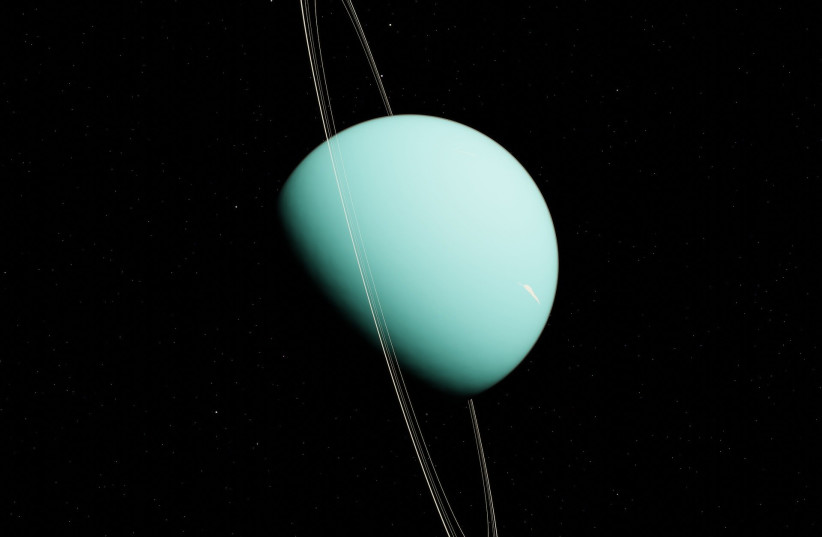NASA's James Webb Telescope has taken a picture of one of the most distant planets in the Solar System, getting a new and better look at Uranus than ever before.
No pun intended here – Uranus's somewhat unfortunate naming has long been the butt of many jokes.
The image, taken with just a short 12-minute exposure, is one of very few ever taken of the distant gas giant to actually show the faint rings orbiting around it – something only ever seen in pictures taken by the Keck Observatory and the Voyager 2 probe.
It also follows the James Webb Space Telescope's historic picture of Neptune, the final planet in the Solar System – unless you count Pluto – taken in 2022.
What is Uranus and why is it unique among all other planets?
The large ice giant (called such because it's a gas giant with icy materials) that is the seventh planet from our Sun, Uranus, has some qualities that stand out among all other worlds in the Solar System. And that doesn't just include the possible "diamond rain."

True, each planet has qualities that make them stand out from the rest. Mercury is incredibly close to the Sun; Venus is a rocky world that is incredibly acidic; Earth has life; Jupiter is the largest and is covered in fierce storms; Saturn has a gigantic set of rings, and so on.
Uranus stands out because it doesn't rotate on a vertical axis. Instead, its axis is more closely aligned with its orbit.
In other words, while most planets spin like tops, Uranus is perpetually somersaulting through space.
This unique quality is reflected in its rings, too.
Several planets possess rings. While Saturn may boast the largest and most visible of them all, Jupiter, Neptune and Uranus all have their own sets of rings orbiting their equators.
This isn't even exclusive to planets. The Sun also has a ring of dust and some moons and other astronomical objects are also thought to have some rings, too. In addition, while it has yet to be conclusively proven, there are also thought to be rings around some exoplanets.
The rings themselves are just accumulations of rocks, ice and other debris caught in the planet's orbit.
But while all observed rings tend to orbit around the planet's equator, meaning horizontally surrounding the planet, Uranus stands out again. Unlike other planets, Uranus's rings are vertical, located along its own orbital spin.
All these details and more were on full display in the James Webb Space Telescope's picture. But these things were all already known. This new picture managed to illustrate some other, lesser-known details about the planet.
First is the fact that Uranus, like Earth, has seasons, but because of its unique rotation, these seasons are very extreme.
Uranus isn't tidally locked so the same sides aren't always facing the Sun. It eventually changes as it completes its 84-year orbit. However, the north and south poles – which are located where the equator would be on most planets – each takes turns to be in either extreme darkness or extreme sunlight.
In the picture, the James Webb Space Telescope was able to observe the northern pole, currently in late spring.
Another thing to consider is color.
Uranus is often simply depicted as being a blueish-green planet with no variation. This is in stark contrast to, for example, Jupiter, which has a vibrant range of swirling colors.
This confusion is understandable, to an extent. After all, in Voyager 2's historic image of Uranus taken in 1986, it certainly appeared to be that way.
But the James Webb Space Telescope is far more advanced and comes equipped with incredibly sensitive imaging technology to get a closer and more detailed look at the planet.
In this new picture, the planet shines more brightly, with more hues of color on display. This is notable because one area, in particular, is especially bright: The polar cap, home in this particular case to Uranus's north pole.
This is something unique for the planet and shines when it is in direct sunlight.
This enhanced brightening is something surprising and it is hoped that watching it more can help scientists learn more about the mysterious phenomenon occurring on this planet.
Of course, there's more to Uranus than just all this. The James Webb Space Telescope picture also captured 11 of the world's 13 known rings as well as many of its 27 known moons.
Further observations hope to capture more details about Uranus – now that we can see what the James Webb Space Telescope can do with just a brief glance, the sky – or rather, Uranus's sky – is the limit for what it can do with a prolonged study.
